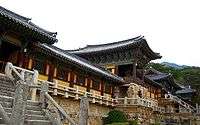Wiman Joseon
Wiman Joseon (194–108 BC) was part of the Gojoseon period (2333 BC? - 108 BC) of Korean history. It began with Wiman's seizure of the throne from Gojoseon's King Jun and ended with the death of King Ugeo who was a grandson of Wiman. Apart from archaeological data, the main source on this period of Korean history comes from chapter 115 of Sima Qian's Shi ji (a.k.a. Records of the Grand Historian).[1] Wiman was a military leader from the state of Yan under the Han dynasty.
Founding
According to Sima Qian, Wiman was a general from the kingdom of Yan established in the early years of the Han Dynasty, who submitted to Gojoseon's King Jun. Jun accepted and appointed Wiman commander of the western border region of Gojoseon, which probably corresponds to the west of the present-day Liaoning. Despite the generosity that King Jun had demonstrated, Wiman revolted and destroyed Gojoseon. In 194 BC, he established Wiman Joseon and decided to locate his capital in Wanggeom-seong (왕검성, 王險城). The exact location of Wanggeom-seong remains unsettled due to lack of definite archaeological evidence, though many believe it was located near modern Pyongyang.
In this period, Wiman Joseon expanded to control a vast territory and became strong economically by controlling trade between the Han Dynasty and the peoples of Manchuria. Emperor Wu of Han thought that Wiman Joseon increasingly threatened Han China, and Wiman Joseon would ally with the Xiongnu.
Fall
Wiman's grandson, King Ugeo (우거,右渠), allowed many exiles from Han China to live in Wiman Joseon. The number of Han grew, however, and King Ugeo prevented the Jin state from communicating with the Han Dynasty. As a result, in 109 BC, Wudi of China invaded Wiman Joseon near the Luan River. After failing several times to defeat Wiman Joseon's armies, Han Wudi tried to convince the princes of Wiman Joseon to kill King Ugeo. The conspiracy failed and it led to the destruction of the Gojoseon kingdom. After the war Wudi of Han China sentenced two generals to death for failing to defeat Wiman Joseon.
After a year of battle, Wanggeom-seong was captured and Wiman Joseon was destroyed. Han China established the Four Commanderies of Han in the captured areas, which corresponds to the current area of Liaodong peninsula and the northwestern Korean peninsula. The Commanderies eventually fell to the rising Goguryeo in 4th century AD.
Several nations were formed in its place. Among them was the Nangnang Nation. The Nangnang Nation must be differentiated from the Lelang commandery.[2]
Monarchs of Wiman Joseon
Maps
See also
Notes
- ↑ Watson, Burton, tr. Records of the Grand Historian: Han Dynasty II. Revised edition. New York, Columbia University Press, 1993. p. 225-230.
- ↑ Lee Hyun-Hee; Park Sung-Soo; Yoon Nae-Hyun (2005). New History of Korea. Jimundang.
References
- Yap, Joseph P. (2009). "Chapter 5. 109 BC". Wars With the Xiongnu: A Translation From Zizhi tongjian. AuthorHouse. ISBN 978-1-4490-0604-4.
External links

 Korea in 108 BC. Gojoseon before destroyed by Han dynasty
Korea in 108 BC. Gojoseon before destroyed by Han dynasty Korea in 315. Goguryeo recovered the former Gojoseon territory.
Korea in 315. Goguryeo recovered the former Gojoseon territory.